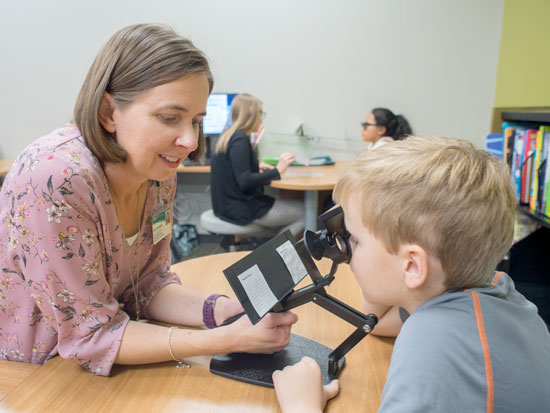 Kristine Hopkins, OD, provides vision therapy to Thompson Spence in the newly renovated space at UAB Eye Care. Seeing is more than being able to read letters on the smallest line of a chart across the room. The University of Alabama at Birmingham School of Optometry recently expanded its Vision Therapy Clinic, enabling more than twice as many patients with conditions affecting eye teaming, visual tracking and focusing to be treated.
Kristine Hopkins, OD, provides vision therapy to Thompson Spence in the newly renovated space at UAB Eye Care. Seeing is more than being able to read letters on the smallest line of a chart across the room. The University of Alabama at Birmingham School of Optometry recently expanded its Vision Therapy Clinic, enabling more than twice as many patients with conditions affecting eye teaming, visual tracking and focusing to be treated.
For routine tasks, one must be able to focus his or her eyes, or accommodate, for long hours while at school or work with accuracy for clear, comfortable vision. Convergence, or the pointing of one’s eyes at the same place on the page or screen, is critical to maintaining a single image of what is being read. Tracking skills, or the ability to follow the words straight across the page without getting lost, or following the path of a moving object, are crucial in performing common daily tasks such as drawing, using computers or playing sports.
Difficulties with these tasks can occur in healthy individuals or can be acquired in patients who have suffered a mild traumatic brain injury. Symptoms of focusing, convergence or tracking systems’ not working properly include eye-strain, blurry vision, headaches, double vision, losing place while reading, avoidance of reading, loss of concentration, words “swimming” on the page or poor reading comprehension.
“When I started at UAB, it was my goal to bring therapy services to our patients and to give the School of Optometry students an education that would allow them to provide vision therapy services to their patients after graduation,” said Kristine Hopkins, O.D., associate professor in the UAB School of Optometry and chief of the UAB Vision Therapy Clinic. “Since moving to the new space, the Vision Therapy Clinic now has the capacity for up to 2,500 therapy visits per year, and third-year optometry students with an interest in binocular vision can elect to have two therapy rotations during their third professional year.”
The Vision Therapy Clinic provides therapy services to patients with conditions like convergence insufficiency, accommodative insufficiency, intermittent exotropia and ocular motor dysfunction on Mondays, Tuesdays and Wednesdays from 3 to 6 p.m. Vision therapy involves a combination of weekly in-office visits and home eye exercises to retrain the visual system to work more efficiently and accurately to relieve symptoms.
“With the addition of Dr. Tamara Oechslin to our clinical staff, we hope to also begin working with children who have visual processing disorders,” Hopkins said.
A continued increase in patients with concussion-related symptoms is expected in the clinic. Within the last few years, more patients with concussions have been sent to the Vision Therapy Clinic, thanks to a rise in recognizing concussions and the School of Optometry’s strong partnership with Children’s of Alabama. This is due largely to the research and collaborations of Katherine Weise, O.D., professor at the School of Optometry, and the concussion team at Children’s of Alabama.